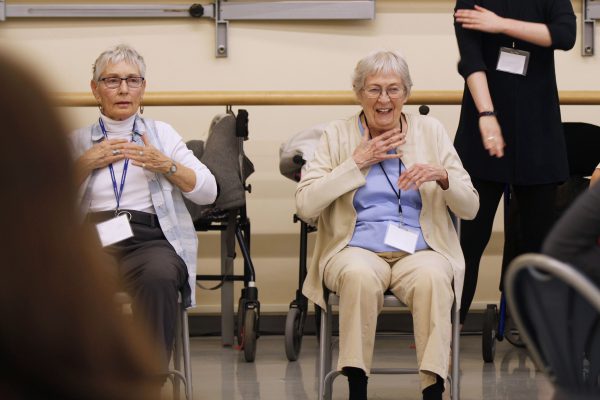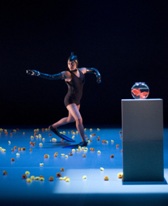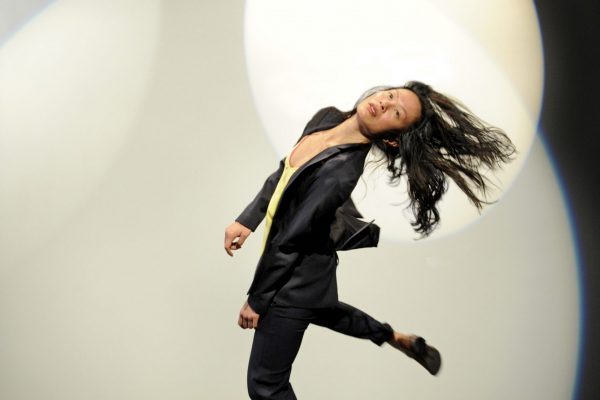Alberta Ballet has never been one to shy away from new ways of “doing” ballet and this season that means sword fighting, swashbuckling and high jumps. Their production of The Three Musketeers is a Canadian premiere, created by David Nixon, artistic director of Northern Ballet in Leeds, England. Energetic and comedic, this work is certainly a crowd-pleaser, and it drew a sold-out audience the night I attended.
Based on the novel by Alexandre Dumas, the ballet follows the hero, D’Artagnan (played by Edmontonian Kelley McKinlay), on his path to becoming a musketeer, with romantic interests, seductions and sword fights along the way. And of course, there are the antics of the three musketeers themselves, played by Jaciel Gomez, Garrett Groat and Yukichi Hattori. Hattori in particular stands out, with his effortless jumps, silly antics and well-timed glances at the audience.
The first scene introduces the main political characters (King Louis XIII, his wife Queen Anne, Cardinal Richelieu and the Duke of Buckingham), and acquaints us with the set, which includes painted backdrops and simple sliding wood panelling. It is not one of the company’s most elaborate sets, but the panelling is used to interesting effect for entrances and exits. In the first scenes we discover several of the choreographic motifs of the ballet: flexed feet, multiple turns and impressive grand allegro. The choreography has a decidedly masculine lean to it, and the scene celebrating the King and Queen’s marriage includes some challenging, well-executed movement for the company’s male dancers.
During this scene we are introduced to Leiland Charles, playing Cinq-Mars. He immediately stands out from the group, with powerful jumps and several impressive, precisely executed turning sequences. Perhaps the most memorable performance in this scene comes from Chris Kaiser, as Louis XIII. As part of the presentation of a diamond necklace to the Queen, he appears in a replica of his wife’s outfit, and proceeds to flit about the stage with the soft port-de-bras and temps-de-flêche of a sylph. The audience eats it up, and Kaiser’s silly and irreverent persona during this scene leaves me considering this reference to Louis XIII’s sexuality, his immaturity, or both.
Another standout performance is delivered by Reilley Bell. She plays the somewhat tragic character of Queen Anne, who is trapped in a loveless marriage with the King, and conducting an affair with the Duke of Buckingham. She is beautifully lyrical, all long limbs and long lines, and her duet with Nicolas Pelletier (as Buckingham) includes some inventive partnering, which is executed smoothly. However, the uniqueness of the pas de deux is sometimes overshadowed by the odd choreographic choices in the angle of the lifts and placement of the supporting hand, making it appear awkward, despite being well performed.
At the end of Act I, we are introduced to D’Artagnan’s love interest, Constance, played by Hayna Gutierrez. The pas de deux includes some impressive partnering by McKinlay, including a one-handed overhead lift, and Gutierrez brings clean technique and an expressive face. But there is one odd choreographic choice in this duet — a partnered attitude turn that recurs two or three times. During one of these sequences, McKinlay is kicked in the leg, at other times he is clearly struggling to avoid Gutierrez’ foot, while still assisting her with the turn, and proving why attitude turns are generally not partnered.
The second act begins with a tongue-in-cheek scene depicting the creation of a ballet by the King and Queen. The dancers perform comical warm-up moves as they wait, and the choreography seems to poke fun at exoticism in ballet, with simplistic “Egyptian” arm and head movements. Charles makes a reappearance in this scene, wowing the audience with a series of turns that draws strong applause.
Later in the act we see an exciting and well-rehearsed sword-fighting sequence between McKinlay and Eli Barnes as the Count de Rochefort, head of the guard. However, a few scenes later, when Milady de Winter (danced by Sky Balfour-Ducharme) provokes Constance into a disagreement, the stage fighting is less impressive. We can clearly see the clapping of hands to simulate a slap, and the choreography is generally uninventive. Perhaps this is an intentionally comic scene, but it looked poorly rehearsed, especially in comparison with the tightly choreographed and brilliantly executed sword fighting we had seen a few moments earlier.
Overall, although there were certain scenes that lagged slightly, the ballet was energetic and well performed, and the audience reacted with applause that stretched through two curtain calls. The scale of the production, combined with the increasingly masterful technique of the dancers of Alberta Ballet, shows how far the company has come in recent years. ~
Meet the choreographer, David Nixon, in the November/December 2014 issue.




